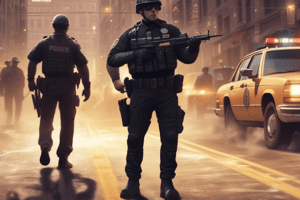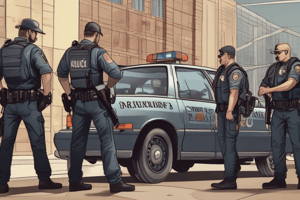Podcast
Questions and Answers
According to the document, which factor is considered when evaluating the reasonableness of force used by a Deputy?
According to the document, which factor is considered when evaluating the reasonableness of force used by a Deputy?
- The presence of large crowds of onlookers.
- The immediacy and severity of the threat to Deputies or others. (correct)
- The subject's favorite color.
- The cost of repairing damages caused during the confrontation.
What is an element related to the individual being confronted that is used to determine force reasonableness?
What is an element related to the individual being confronted that is used to determine force reasonableness?
- The subject's employment history.
- The stock market performance of the day.
- The subject's favorite food.
- The conduct of the individual as reasonably perceived by the Deputy. (correct)
Deputy and subject factors taken into account include all of the following EXCEPT:
Deputy and subject factors taken into account include all of the following EXCEPT:
- The number of Deputies available versus the number of subjects.
- The subject's shoe size. (correct)
- Injuries sustained and level of fatigue.
- Age, size and relative strength.
Which factor relates to the potential presence of dangerous items?
Which factor relates to the potential presence of dangerous items?
What is considered relevant regarding the subject's condition?
What is considered relevant regarding the subject's condition?
According to the policy, what is considered deadly force?
According to the policy, what is considered deadly force?
When is the use of physical techniques or tactics by a law enforcement member NOT considered a use of force?
When is the use of physical techniques or tactics by a law enforcement member NOT considered a use of force?
According to this document, which of these should be considered?
According to this document, which of these should be considered?
What is an expectation of all members of the office regarding the use of force?
What is an expectation of all members of the office regarding the use of force?
Which item below is a factor to consider relating to any previous interactions?
Which item below is a factor to consider relating to any previous interactions?
If the conduct of an individual appears to no longer reasonably pose an imminent threat to the Deputy or others, what can be said?
If the conduct of an individual appears to no longer reasonably pose an imminent threat to the Deputy or others, what can be said?
What is the responsibility of a Deputy who observes another Deputy using clearly unreasonable force?
What is the responsibility of a Deputy who observes another Deputy using clearly unreasonable force?
What does the policy emphasize when it comes to the value of human life?
What does the policy emphasize when it comes to the value of human life?
According to this policy, what is the purpose of providing guidelines on the use of force?
According to this policy, what is the purpose of providing guidelines on the use of force?
What is required to ensure deputies use their authority to employ reasonable force and protect the public appropriately?
What is required to ensure deputies use their authority to employ reasonable force and protect the public appropriately?
What is a key aspect that Deputies must understand regarding their authority, as emphasized in the policy?
What is a key aspect that Deputies must understand regarding their authority, as emphasized in the policy?
When using pain compliance techniques, what is a crucial consideration regarding the subject's actions?
When using pain compliance techniques, what is a crucial consideration regarding the subject's actions?
What is the primary goal when employing pain compliance techniques?
What is the primary goal when employing pain compliance techniques?
According to the guidelines, which of the following best describes the circumstances under which deadly force is justified?
According to the guidelines, which of the following best describes the circumstances under which deadly force is justified?
What does the guideline mean by 'imminent' when discussing deadly force?
What does the guideline mean by 'imminent' when discussing deadly force?
Besides self-defense, when can deadly force be used against a fleeing subject?
Besides self-defense, when can deadly force be used against a fleeing subject?
What type of questions are recommended to engage a mentally ill person in their own problem-solving process?
What type of questions are recommended to engage a mentally ill person in their own problem-solving process?
What is the main idea behind using suggestibility when speaking to a subject?
What is the main idea behind using suggestibility when speaking to a subject?
According to the document, what is the first step a deputy should consider when using a pain compliance technique?
According to the document, what is the first step a deputy should consider when using a pain compliance technique?
When should supervisory notification be made after the application of force?
When should supervisory notification be made after the application of force?
What action MUST a supervisor take when an application of force is reported?
What action MUST a supervisor take when an application of force is reported?
Apart from handcuffs, shackles, or belly chains, what other restraint device requires notification after it's application?
Apart from handcuffs, shackles, or belly chains, what other restraint device requires notification after it's application?
Who is responsible for informing medical personnel about the use of force on a subject?
Who is responsible for informing medical personnel about the use of force on a subject?
What specific information should be included when notifying medical personnel about the use of force?
What specific information should be included when notifying medical personnel about the use of force?
If an individual who was subjected to force refuses medical attention, what should be documented?
If an individual who was subjected to force refuses medical attention, what should be documented?
Which of the following requires obtaining medical assistance prior to booking or release?
Which of the following requires obtaining medical assistance prior to booking or release?
Which of the following best describes 'excited delirium'?
Which of the following best describes 'excited delirium'?
When is it required to continuously monitor an individual after an encounter that involved force?
When is it required to continuously monitor an individual after an encounter that involved force?
What action should deputies take when they suspect a subject is experiencing a medical emergency?
What action should deputies take when they suspect a subject is experiencing a medical emergency?
When is a Deputy authorized to use any means available for protection?
When is a Deputy authorized to use any means available for protection?
What is the threshold for requiring supervisory notification after applying force when considering discomfort?
What is the threshold for requiring supervisory notification after applying force when considering discomfort?
What constitutes a valid reason for obtaining medical assistance for an individual who was subjected to force?
What constitutes a valid reason for obtaining medical assistance for an individual who was subjected to force?
Which of the following is explicitly mentioned as an unauthorized technique except under exceptional use of force situations?
Which of the following is explicitly mentioned as an unauthorized technique except under exceptional use of force situations?
According to the content, what is a key factor that may increase a subject’s risk of sudden death?
According to the content, what is a key factor that may increase a subject’s risk of sudden death?
If a deputy uses force, what must the notification to medical personnel always include?
If a deputy uses force, what must the notification to medical personnel always include?
According to the document, what factor is NOT considered when judging the reasonableness of force used by a deputy?
According to the document, what factor is NOT considered when judging the reasonableness of force used by a deputy?
What is the primary purpose of utilizing de-escalation techniques, as stated in the document?
What is the primary purpose of utilizing de-escalation techniques, as stated in the document?
Which of the following is NOT a recommended de-escalation technique according to the document?
Which of the following is NOT a recommended de-escalation technique according to the document?
What does the document suggest a deputy should do if there is nothing to apologize for directly in a situation?
What does the document suggest a deputy should do if there is nothing to apologize for directly in a situation?
Why does the document emphasize the importance of 'agreeing' as a de-escalation technique?
Why does the document emphasize the importance of 'agreeing' as a de-escalation technique?
According to the document, what should a deputy consider when responding to a subject who might be angry or in emotional distress?
According to the document, what should a deputy consider when responding to a subject who might be angry or in emotional distress?
What does the document imply about the timing of de-escalation attempts during an incident?
What does the document imply about the timing of de-escalation attempts during an incident?
According to the document, what does 'listening' accomplish as a de-escalation technique?
According to the document, what does 'listening' accomplish as a de-escalation technique?
Flashcards
Deadly Force
Deadly Force
Force that is reasonably anticipated to cause a substantial likelihood of death or very serious injury.
Force
Force
The application of physical techniques, tactics, chemical agents, or weapons to another person.
Policy on Use of Force
Policy on Use of Force
The use of force by law enforcement personnel is a serious matter, both for the public and the law enforcement community.
Duty of Understanding Authority
Duty of Understanding Authority
Signup and view all the flashcards
Duty to Intercede
Duty to Intercede
Signup and view all the flashcards
Reporting Excessive Force
Reporting Excessive Force
Signup and view all the flashcards
Respect for Human Dignity
Respect for Human Dignity
Signup and view all the flashcards
Monitoring and Evaluation
Monitoring and Evaluation
Signup and view all the flashcards
Force Continuum
Force Continuum
Signup and view all the flashcards
De-escalation Techniques
De-escalation Techniques
Signup and view all the flashcards
Listening
Listening
Signup and view all the flashcards
Acknowledge
Acknowledge
Signup and view all the flashcards
Agree
Agree
Signup and view all the flashcards
Apologize
Apologize
Signup and view all the flashcards
Threat Severity
Threat Severity
Signup and view all the flashcards
Subject's Conduct
Subject's Conduct
Signup and view all the flashcards
Officer and Subject Factors
Officer and Subject Factors
Signup and view all the flashcards
Influence of Drugs/Alcohol
Influence of Drugs/Alcohol
Signup and view all the flashcards
Subject's Mental State
Subject's Mental State
Signup and view all the flashcards
Presence of Weapons
Presence of Weapons
Signup and view all the flashcards
Effectiveness of Restraint
Effectiveness of Restraint
Signup and view all the flashcards
Alternative Options
Alternative Options
Signup and view all the flashcards
Clarification in law enforcement
Clarification in law enforcement
Signup and view all the flashcards
Sequence Questions
Sequence Questions
Signup and view all the flashcards
Suggestibility in Law Enforcement
Suggestibility in Law Enforcement
Signup and view all the flashcards
Pain Compliance Techniques
Pain Compliance Techniques
Signup and view all the flashcards
Deadly Force Justification
Deadly Force Justification
Signup and view all the flashcards
Deadly Force and Fleeing Suspects
Deadly Force and Fleeing Suspects
Signup and view all the flashcards
Blue Team Report
Blue Team Report
Signup and view all the flashcards
When to Notify Supervisor
When to Notify Supervisor
Signup and view all the flashcards
Medical Assistance after Force
Medical Assistance after Force
Signup and view all the flashcards
Who provides Medical Assistance?
Who provides Medical Assistance?
Signup and view all the flashcards
Documenting Refusal of Medical Attention
Documenting Refusal of Medical Attention
Signup and view all the flashcards
Notification of Force Used
Notification of Force Used
Signup and view all the flashcards
Excited Delirium
Excited Delirium
Signup and view all the flashcards
Exceptional Use of Force
Exceptional Use of Force
Signup and view all the flashcards
Excited Delirium Calls as Emergencies
Excited Delirium Calls as Emergencies
Signup and view all the flashcards
Requesting Medical Assistance
Requesting Medical Assistance
Signup and view all the flashcards
Deputy Training for Force
Deputy Training for Force
Signup and view all the flashcards
Chokeholds and Neck Restraints
Chokeholds and Neck Restraints
Signup and view all the flashcards
Documentation of Force
Documentation of Force
Signup and view all the flashcards
Study Notes
300 Use of Force
- This policy provides guidelines for the reasonable use of force by law enforcement.
- Deputies must use force in a professional, impartial, and reasonable manner.
Definitions
- Deadly force: Force intended to cause death or serious injury.
- Force: Using physical techniques, tactics, chemical agents, or weapons against another person. Not considered force if a person allows themselves to be searched, escorted, handcuffed, or restrained.
Policy
- The use of force by law enforcement is a matter of critical concern.
- Deputies are involved in numerous interactions daily and may use reasonable force when warranted.
- Deputies must understand their authority and limitations, especially when overcoming resistance.
- The Office values all human life and dignity. The use of force must be balanced with protecting the public.
Duty to Intercede
- Any Deputy witnessing another Deputy using excessive force must intervene.
- Deputies must report any observed excessive force to a Supervisor immediately.
Use of Force
- Deputies should only use the amount of force reasonably necessary in a given situation.
- Reasonableness is judged from the perspective of a reasonable Deputy on the scene.
- Deputies often make split-second decisions with limited information, and circumstances may be tense and rapidly evolving.
- Discretion is required when determining appropriate force in each incident.
- Tools, weapons or methods may not be effective in all circumstances. Deputies can improvise as necessary.
- Protecting the public welfare takes priority, but Deputies do not need to retreat from a possible physical encounter if reasonable force is applied.
Factors Determining Reasonableness of Force
- Immediacy and severity of the threat (to the Deputy or others)
- Conduct of the subject
- Subject factors like age, size, skill, level of exhaustion or injuries, the presence of alcohol or drugs, or mental state
- Proximity of weapons or dangerous devices
- Degree to which the subject can be restrained and ability to resist
- Options available, effectiveness.
- Seriousness of the offense
- Deputy's training and experience
- Potential for injury from the incident or other factors
De-escalation
- Deputies should use the minimum amount of force necessary.
- De-escalation techniques are recommended, including listening, acknowledging the subject's emotions, agreeing with certain statements, and apologizing.
- Sequence questions and suggestibility.
Pain Compliance Techniques
- These techniques may be used to control a resisting individual.
- Deputies must have completed training.
- Use of these techniques considers the level of resistance and whether the subject can comply.
- Pain compliance should be discontinued once compliance is achieved.
Deadly Force
- Deputies can use deadly force to defend themselves or others from situations of imminent death or serious physical injury.
- This can include stopping a fleeing subject if the officer has probable cause that the subject committed a felony involving serious injury or death, and there's an imminent threat.
Shooting at Moving Vehicles
- Shooting at moving vehicles is rarely effective. Deputies should attempt to either avoid the vehicle or only use force (other than shooting at the vehicle itself) when necessary to prevent harm.
Reporting Use of Force
- All incidents of force must be documented promptly and accurately.
- Factors for the use of force must be clearly articulated.
- The nature of the force or circumstances must be reported, and additional forms as required by the Office procedures must be filled out.
Notification to Supervisors
- Supervisor notification is required in certain situations, such as a visible injury, pain, or injuries that may extend beyond discomfort, indication of intent to litigate, or use of non-standard restraints.
Supervisor Duty to Report
- Supervisors need to complete a Blue Team report (SOP 309.1) when an incident of force occurs.
Medical Consideration
- Medical assistance is required for individuals exhibiting physical distress or injuries after an incident.
- Refusal of medical care must be documented.
Exceptional Use of Force
- Use of advanced techniques can be used if an imminent threat to the deputy or another is present.
- Restraints like chokeholds are not authorized.
Training
- Deputies must receive periodic training on this policy.
Studying That Suits You
Use AI to generate personalized quizzes and flashcards to suit your learning preferences.



